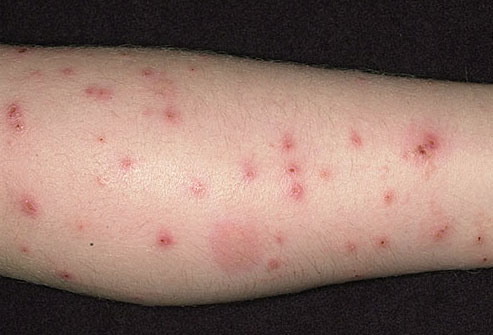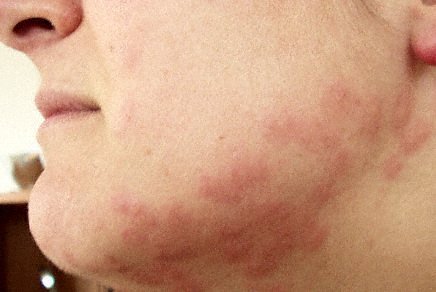Have you ever gotten out of bed wondering if that red, itchy spot on your leg was from a flea or bed bug? Although it can be difficult to distinguish flea bites and bed bug bites, there are some clues that will help you distinguish between the two. Before we dive into the flea bites vs. bed bug bites contrast, let's first take a separate look at each bite.
Flea Bites
Characteristics of Flea Bites
Fleas are parasites that obtain nourishment from the blood of their host. Flea bites can easily be confused with ant bites, spider bites, or skin allergies. However there are some clues these pests leave behind to help identify the origin of the bite. One simple way to differentiate between bites is to look at the bite itself. A bite with two puncture marks is most likely from an ant or spider; whereas, a bite with one puncture mark in the center of the bite is most likely from a flea.
There are several other symptoms associated with flea bites. Here are the most common symptoms:
- A red, swollen area appears on the skin about thirty minutes after the initial bite.
- The infected area turns red and begins to itch. The itch is irritating and constant.
- Within two days of the bite, the wound can turn into a blister.
- The constant itching can cause the area to bleed or become infected.
- In rare cases, individuals will have an allergic reaction to the flea bite that can result in difficulty breathing, chest pain, and hives.
Treatments for Flea Bites
Most flea bites can be easily managed at home and this is one vital part in the flea bites vs. bed bug bites contrast. The most important part in managing flea bites is being able to resist the urge to scratch the bite. Just treat flea bites at home in the following ways:
- As soon as you identify the bite, clean the area with soap and water and pat the area dry using a clean towel. This will help decrease the risk of infection.
- Apply calamine lotion or hydrocortisone cream to relieve the itching.
- Place a cold compress over the affected area, several times a day to decrease the amount of swelling and inflammation.
Preventive Measures for Flea Bites
The key to preventing flea bites is to eliminate the source of the infestation. To do this, pet owners need to treat all pets with flea shampoo or flea spot on treatment liquids. Removing fleas from your home can be difficult because of the following reasons:
- Fleas reproduce at an alarming rate.
- Flea eggs can take up to two weeks to hatch.
- Fleas can live up to three months.
To control fleas, treat all carpeted areas and pet bedding with flea insecticide sprays, foggers, or powders. Since flea eggs can live for weeks inside the home or pet bedding, a second treatment is often needed.
If you prefer to treat fleas naturally, begin by washing all clothing, bedding, and pet bedding in hot water. Then dry the materials in the dryer on high heat to help remove the pests and kill the eggs. Next sprinkle borax on the carpeted areas, mattresses, and outdoor areas. Allow the borax powder to sit for several hours and then remove with a vacuum. It is extremely important that you empty and remove the vacuum bag from your home to avoid reinfestation. Continue this treatment every week up to one month.
Bed Bug Bites
Characteristics of Bed Bug Bites
Bed bugs are small, non-flying insects that obtain nourishment from the blood they remove from humans or animals. Although bed bugs can live in furniture and upholstery, they prefer to congregate in beds and bed frames where they feed at night. Bed bugs bites are commonly found on the hands, neck, face, and arms because these areas are more likely to be exposed during sleep. The bumps appear on the skin as flat, small, or raised areas that can become inflamed, itchy, red or blistered.
Treatments for Bed Bug Bites
When it comes to the flea bites vs. bed bug bites contrast, you should never miss this part. Often no treatment is required for bed bug bites. However, if the bites itch, you can treat them with topical steroid creams or oral antihistamines. A course of oral antibiotics may be prescribed to treat an infection that develops at the bed bug site.
Preventive Measures for Bed Bug Bites
Most often an infestation of bed bugs will require a pest-control expert because bed bugs are highly adaptable pests that can live for up to a year without feeding.
You can try to spray or dust insecticides to remove bed bugs from your home but these products must be applied to all areas where bed bugs congregate including cracks in the furniture, holes in the walls, and other crevices found throughout the residence. Since it is virtually impossible to remove all bed bugs from a bed or mattress, you will need to discard all mattresses and bedding infected with bed bugs.
Pest-control experts can identify areas in your home where bed bugs hide or crawl. These experts can help prevent future bed bug infestations by filling in cracks in the tile, hardwood floors, and crown moldings and enclosing all mattresses with protective bags.
So the next time you wake up with a red, itchy bite on your leg, you can follow our flea bites vs. bed bug bites contrast to determine the causes of your condition. Here is a quick guide that you can refer to the next time you get bitten!
Table: Difference between Flea Bites and Bed Bug Bites
|
Symptoms of Flea Bites |
Symptoms of Bed Bug Bites |
|---|---|
|
Small bump surrounded by a red skin rash. |
Look similar to mosquito bites. Reddened raised area. |
|
Appear in groups of three or four. More commonly found on the ankles, armpits, waist, bends of knees, and elbows but can be anywhere on the body. |
Appear in a straight pattern in rows of three or more. Typically located on the neck, face, arms, and hands but can be anywhere on the body. |
|
Continuous bites. |
Intermittent bites. |
|
The bites itch. |
The bites itch and appear inflamed. |
|
The rash turns white when you press your fingers on it. |
The bites may result in a blister. |


